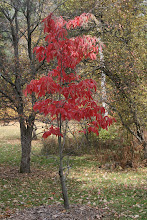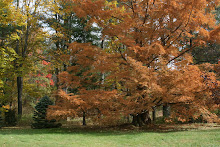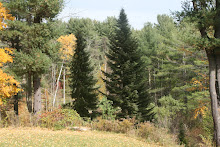Thursday, January 3, 2013
Why Evergreens are Green in Winter – Winter Photosynthesis
When
you look off the back patio at the arboretum during the winter months it’s such
a different scene then during the spring, summer or fall because most of the
leaves are off the trees. Not only can
you see farther down into the property from the same vantage point but what really
stands out to me are the highlights of green trees scattered throughout the
property. We all
know that when the seasons change and it starts to get cold and the days get
shorter deciduous trees automatically cut off connections to their leaves and
stop performing photosynthesis in order to save energy for the upcoming winter
months. But some plants and trees keep
their leaves all winter and they stay green.Trees
like evergreens and conifers continue to stay green all winter
because they have evolved special adaptions to survive the cold climate where
they grow.
First, these trees have
needles rather than leaves. The needles
are a way of protecting their foliage all year round. Snow easily falls off them. The shape of the needle and its waxy coating
is also designed to conserve water and minimize evaporation. These trees feed themselves all winter by
keeping chlorophyll in their needles by using smaller amounts of energy it
produces during the winter. The
chlorophyll is the chemical that makes photosynthesis possible and what causes
the needles to look green. Plants that
perform winter photosynthesis spend time during the spring and summer storing
energy. In simple terms, during the coldest
months, evergreens convert these starch cells back to simple sugars that can be
used to produce energy and food for the plant system, or to provide energy for
new growth in the spring.
Also, evergreens
are able to conduct photosynthesis in winter because the cells in the needles
are protected by a type of self-made antifreeze that is carried in the tree
sap. The cold temperatures and lack of
sunlight cause the photosynthesis process to occur more slowly and it is not as
efficient as warm weather photosynthesis which is why some needles end of
falling off the tree but many do not.
If you want to see
some winter photosynthesis in action visit the arboretum and see what nature
has to offer. The arboretum grounds are
open all year round. Happy New Year!
--- Sue Abbuhl
Subscribe to:
Posts (Atom)











